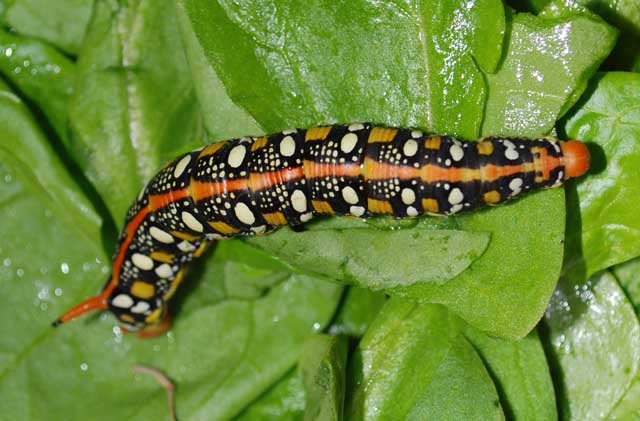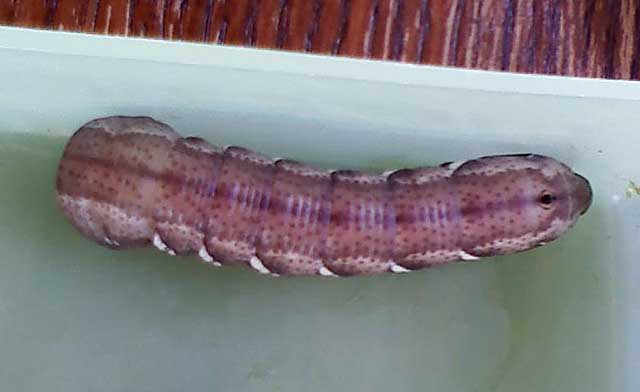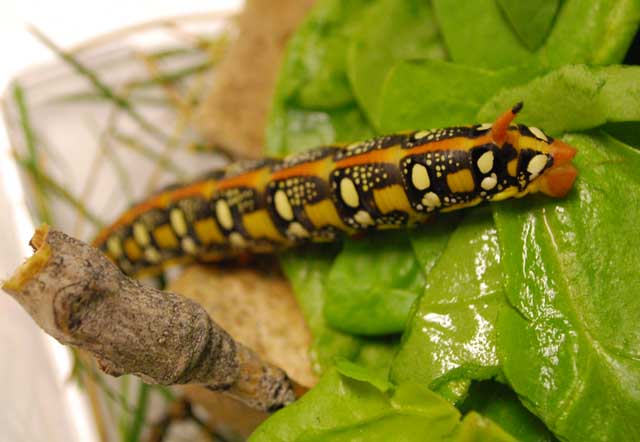Sphinginae subfamily
Sphingini Tribe:
 |
Ceratomia amyntor
WO,
Elm Sphinx or Four-horned Sphinx:
Larvae feed on Elm (Ulmus), birch (Betula), basswood
(Tilia), and cherry (Prunus).
There are both green and brown forms. The four horns near
the head are diagnostic. |
 |
Ceratomia undulosa
USGS, Waved
Sphinx:
Note the pinkish-orange tail, spiracles outlined in red and the cream
stripes on the head.
The dramatic color change from the dorsal
yellow-green to the lateral light greyish-blue is not always
as intense as in this image.
|
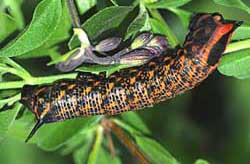 |
Lintneria separatus
USGS,
Separated Sphinx: Salvia greggii has been confirmed as host
by Robert A. Behrstock. Jim Tuttle, tentative id, writes, "All penultimate instars of both Lintneria (Sphinx) istar and
Lintneria (Sphinx) separatus that I have reared
have been mundane green."
|
 |
Manduca quinquemaculatus
USGS,
the Five-spotted Hawkmoth:
The caterpillars are called Tomato Hornworms and each has a black horn at the end of the abdomen.
Larvae feed on potato, tobacco, tomato, and other plants in the
nightshade family (Solanaceae).
|
 |
Note the red horn and black dots anterior to the white oblique lines.
If you grow tomatoes, you have probably encountered it.
|
 |
Sphinx chersis
WO, Northern Ash Sphinx or Great Ash
Sphinx: Pale bluish green. Head has pair of yellow
lateral bands meeting at apex. Oblique, lateral stripes:
pale; bordered anteriorly with darker green. Ash, lilac, privet, cherry, quaking aspen.
|
 |
Sphinx drupiferarum
WO,
Wild Cherry Sphinx:
Larvae hide in the day and feed primarily on cherry, plum, and apple
at night. Larvae have been found on Amelanchier nantuckensis
in Massachusetts and have been reared to pupation in Michigan on
Prunus serotina. Note purple oblique lines.
|
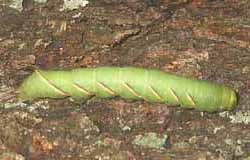 |
Sphinx luscitiosa
WO,
the Canadian Sphinx or
Clemen's Sphinx
This one is reported from Richmond and from northeastern New
Jersey into southern Canada.
|
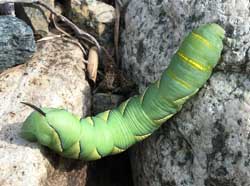 |
Sphinx vashti
USGS,
Snowberry Sphinx: Larvae feed on common snowberry (Symphoricarpos albus)
and on coralberry (S. orbiculatus).
Note two golden
lines of slightly raised bumps, one just behind the head, the other
on the thorax.
|
Smerinthini Tribe:
 |
Pachysphinx modesta
WO,
the Modest Sphinx or Poplar Sphinx
This moth is officially recorded in Delaware County. It is fond
of poplars and
willows.
|
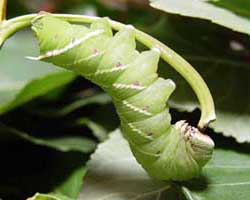 |
Larvae feed on cottonwood and poplar (Populus) and willow
(Salix).
Larvae are very chunky with little to distinguish them
from Pachysphinx modesta.
|
 |
Paonias excaecata
WO,
the Blinded Sphinx:
Larvae accept willows, birches, and cherries.
I have also found them in the wild on oak in eastern Canada.
|
 |
Paonias myops
WO, Small-eyed Sphinx:
Wild cherry species are favorites as larval foodplants, but eggs
will also be deposited on birches and other forest trees.
There are varying degrees in the amount of red markings along the sides.
|
 |
Smerinthus cerisyi
USGS,
Cerisy's Sphinx;
Pale green, granular skin, pale lateral diagonal lines, faint red
spiracular circles, very pale longitudinal lines running from
head to more pronounced anal diagonal line.
Green heads bounded dorsally with pale yellow
inverted "V". questionable
|
 |
Smerinthus jamaicensis
USGS,
the Twin-spotted Sphinx:
Larvae feed upon many forest trees including birches and cherries,
but are expecially fond of poplars and willows. Red markings on sides
vary greatly from specimen to specimen.
|
Macroglossinae subfamily
Dilophonotini Tribe
 |
Hemaris diffinis
USGS,
Snowberry Clearwing; Bumblebee Moth:
Snowberry (Symphoricarpos),
honeysuckle (Lonicera), Coralberry, viburnums, Blue Dogbane
(Apocynum) dwarf bush honeysuckle (Diervilla lonicera).
Horn: black; yellow base.
|
Philampelini Tribe:
 |
Eumorpha achemon
USGS/TM/LP,
Achemon Sphinx:
Grape (Vitis), Virginia Creeper
(Parthenocissus quinquefolia), other vines and ivies
(Ampelopsis).
Larvae occur in both a light (green) form and a darker (tan/brown)
form. Note six "segmented" oblique lines.
|
Eumorpha achemon, Evan, August 9, 2010, Tisa Morehead and Lisa Petersen
Macroglossini Tribe
 |
Amphion floridensis
WO,
Nessus Sphinix:
In additon to Virginia creeper larvae accept Grape (Vitis),
ampelopsis (Ampelopsis), cayenne pepper (Capsicum).
Larvae are green until the final instar.
|
 |
Darapsa myron WO, Virginia Creeper Sphinx; Grapevine Sphinx:
If you have the
foodplants indicated in common names, you probably have this
species nearby. Lower wings are orange.
Virginia creeper (Parthenocissus quinquefolia),
Grape (Vitis), Ampelopsis, Viburnum.
|
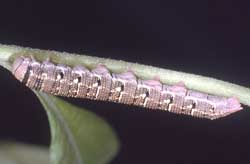 |
Euproserpinus wiesti
USGS,
Wiest's Primrose Sphinx:.
Adults fly during the day, over sand washes
and prairie blow-outs as single brood from May-June. Prairie primrose (Oenothera latifolia) in evening primrose family (Onagraceae).
Trying to rear in captivity has proven difficult. Larvae need sunshine, heat, humidity.
|
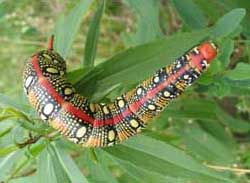 |
Hyles euphorbiae
TJ, Leafy Spurge Hawk Moth:
Leafy spurge. Larvae are also conspicuously colored, with
pronounced tail or "horn" near rear end.
Young larvae are variously patterned with green, yellow, and black;
older larvae have distinctive red, black, yellow, and white color
pattern. Mature larvae may approach 10 cm in length; when disturbed,
they regurgitate a slimy green liquid.
|
Hyles euphorbiae fifth instar, Poudre River Trail, Greeley, Weld County, Colorado,
September 9, 2009, courtesy of Tyson Fisher via Tiffany Joy.
 |
Hyles gallii
USGS, Bedstraw Hawk Moth
or Gallium Sphinx:
Larvae come in black and in brown forms and often feed on
Epilobium (fireweed).
|
 |
Hyles lineata
USGS, White-lined Sphinx:
Larvae are highly varied; feed on diversity of plants:
willow weed (Epilobium), four o'clock (Mirabilis),
apple (Malus), evening primrose (Oenothera), elm
(Ulmus), grape (Vitis), tomato (Lycopersicon),
purslane (Portulaca), Fuschia.
All larvae seem, however, to have red/black swellings split by
dorso-lateral lines.
|
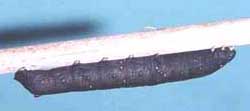 |
Proserpinus flavofasciata
WO, Yellow-banded Day Sphinx:
Willow weed (Epilobium); possibly thimbleberry (Rubus parviflorus).
slight possibility
|
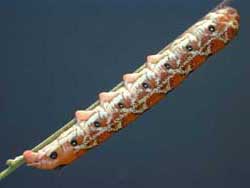
|
Proserpinus juanita
USGS,
the Juanita Sphinx:
Larvae feed on (Onagraceae) including evening primrose
(Oenothera), gaura (Gaura), and willow weed
(Epilobium).
Early instars are green and lack the dark sharply contrasting
spiracular circles and other patterning.
|
|
|
